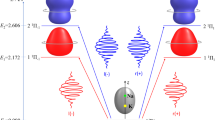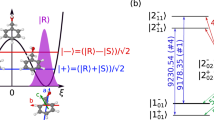Abstract
We present theoretical considerations and quantitative numerical simulations of the coherent radiative excitation of chiral molecules exhibiting a double well potential in the electronic ground state (with stable enantiomers) and a harmonic oscillator potential with achiral minimum geometry in the excited electronic state following a scheme proposed in [33]. The one-dimensional short time dynamics is presented on the femtosecond time scale. We demonstrate the phenomena of quasiexponential, radiationless decay of the survival probability in the excited electronic state by simple harmonic oscillator wave packet motion, as well as coherent periodic chiral stereomutation. The differences and similarities of the excited state harmonic oscillator dynamics with two quite different ground state potentials are discussed. A designed pulse sequence allows for chemically efficient laser controlled stereomutation with high enantiomeric specificity. The results are discussed in relation to Friedrich Hund's early work on stereomutation by tunneling and in relation to our current understanding of chiral molecules including dynamical chirality and anharmonic vibrational dynamics on the femtosecond time scale and the violation of parity and other fundamental symmetries.
Similar content being viewed by others
References
Zare, R.N.: Angular momentum. New York: Wiley 1988
Hund, F.: Z. Phys.36, 257 (1926);37, 742 (1927);40, 742 (1927);42, 93 (1927);43, 788 (1927);51, 759 (1928)
Mulliken, R.S.: Phys. Rev.32, 186 (1928); Mulliken, R.S.: J. Chem. Phys.43, 22 (1965); Pure Appl. Chem.24, 203 (1970); Ann. Rev. Phys. Chem.29, 1 (1978); Nobel prize lecture in Les Prix Nobel en 1966, p. 137
Hund, F.: Z. Phys.43, 805 (1927)
van't Hoff, J.H.: Arch. Neerl. Sci. Exactes Nat.9, 445 (1874);
le Bel, J.A.: Bull. Soc. Chim. Fr.22, 337 (1874): English translations of both papers appear in Classics in the Theory of Chemical Combinations. O.T. Benfey, (ed.) New York: Dover Publications 1963
van't Hoff, J.H.: Vorlesungen über theoretische und physikalische Chemie, Bd. 2. Braunschweig: Vieweg 1899; Die Lagerung der Atome im Raume. Braunschweig: Vieweg 1876; In: Bazendijk, P.M. (ed.) La chimie dans l'espace. Rotterdam 1887
Janoschek, R.: In: Chirality. Janoschek, R. (ed.) p. 18. Berlin: Springer 1991
Gamow, G.: Z. Phys.51, 204 (1928)
Guerney, R.W., Condon, E.U.: Nature122, 439 (1928)
Fowler, R.H., Nordheim, L.: Proc. Roy. Soc. A119, 173 (1928)
Quack, M.: Chapter 27 in Femtosecond Chemistry. Manz, J., Woeste, L. (eds.) Proc. Berlin Conf. Femtosecond Chemistry Berlin (March 1993). Weinheim: Verlag Chemie 1994, pp. 781–818
Quack, M., Stockburger, M.: J. Mol. Spectrosc.43, 87 (1972)
Quack, M.: Angew. Chem.101, 588 (1989); Angew. Chem. Int. Ed. English28, 571 (1989)
Lee, T.D., Yang, C.N.: Phys. Rev.104, 254 (1956); Wu, C.S., Ambler, E., Hayward, R.W., Hoppes, D.D., Hudson, R.P.: Phys. Rev.105, 1413 (1957)
Salam, A.: Proc. Eighth Nobel Symp. Stockholm (1968) p. 367
Weinberg, S.: Phys. Rev. Lett.19, 1264 (1967)
Glashow, S.L.: Nucl. Phys.22, 579 (1961)
Primas, H.: Chemistry, quantum mechanics and reductionism. Berlin: Springer 1981
Pfeifer, P.: In: Energy storage and redistribution in molecules. (Proc. of Two Workshops, Bielefeld 1980) Hinze, J. (ed.) New York: Plenum 1983, p. 315
Amann, A.: In: Fractals, quasicrystals, chaos, knots and algebraic quantum mechanics. Amann, A. (ed.) Dordrecht: Kluwer 1988, p. 305; see also Amann, A., Gans, W.: Angew. Chem.101, 277 (1989); Angew. Chem. Int. Ed. English28, 268 (1989)
Leggett, A.J., Chakravarty, S., Dorsey, A.T., Fisher, M.P.A., Garg, A., Zwerger, W.: Rev. Mod. Phys.59, 1 (1987)
Harris, R.A., Stodolsky, L.: J. Chem. Phys.74, 2145 (1981)
Quack, M.: Hund/Klemm lecture. Wie bewegen sich Moleküle?, Max-Planck-Institut Stuttgart 1986 (partly published in [12]); Die Symmetrie von Zeit und Raum und ihre Verletzung in molekularen Prozessen. Jahrbuch 1990–1992 der Akademie der Wissenschaften zu Berlin. Berlin: de Gruyter, W. p. 469; In: Conceptual Tools for Understanding Nature. Proc. 2nd Int Symp of Science and Epistemology Seminar, Trieste April 1993. Costa, G., Calucci, G., Giorgi, M. (eds.) Singapore: World Scientific Publ. 1995, p. 172
Rein, D.W.: J. Mol. Evol.4, 15 (1974)
Letokhov, V.S.: Phys. Lett. A53, 275 (1975)
Ya Zeldovich, B., Saakyan, D.B., Sobelman, I.I.: Sov. Phys. JETP Lett.25, 94 (1977)
Harris, R.A., Stodolsky, L.: Phys. Lett.78B, 313 (1978); J. Chem. Phys.73, 3862 (1980)
Rein, D.W., Hegstrom, R.A., Sandars, P.G.H.: Phys. Lett.71A, 499 (1979)
Hegstrom, R.A., Rein, D.W., Sandars, P.G.H.: J. Chem. Phys.73, 2329 (1980)
Mason, S.: Nature (London)314, 400 (1985)
Mason, S.F., Tranter, G.: Chem. Phys. Lett.94, 34 (1983); Mol. Phys.53, 1091 (1984)
Tranter, G.E.: Chem. Phys. Lett.120, 83 (1985); ibid.121, 339 (1985); Mol. Phys.56, 825 (1985); Chem. Phys. Lett.135, 279 (1987); Nachr. Chem. Techn. Lab.34, 866 (1986); Nature (London)318, 172 (1985)
Bakasov, A., Ha, T.K., Quack, M.: to be published
Quack, M.: Chem. Phys. Lett.132, 147 (1986)
Cina, J., Harris, R.A.: J. Chem. Phys.100, 2531 (1994)
Quack, M.: J. Mol. Struct.292, 171 (1993); ibid.347, 245 (1995)
Quack, M.: Verh. Dtsch. Phys. Ges. IV28, 243 (1993); Chem. Phys. Lett.231, 421 (1994)
Barron, L.D.: Chem. Phys. Lett.221, 311 (1994)
Dohle, M., Manz, J., Paramonov, G.K.: Ber. Bunsenges. Phys. Chem.99, 478 (1995); see also D.J. Tannor and S.A. Rice, J. Chem. Phys.83, 5013 (1985) for related strategies of reaction control and D.W. Lupo and M. Quack, Chem. Rev.87, 181 (1987) for a review of mode selectivity in reaction control
Quack, M., Sutcliffe, E.: Infrared Phys.25, 163 (1985)
Marquardt, R., Quack, M.: J. Chem. Phys.90, 6320 (1989); Infrared Phys.29, 485 (1989)
Marquardt, R., Quack, M.: J. Phys. Chem.94, 3486 (1994)
Pepper, M.J., Shavitt, I., Schleyer, P.v.R., Glukhovtsev, M.N., Janoschek, R., Quack, M.: J. Comp. Chem.16, 207 (1995)
Peyerimhoff, S.D., Lewerenz, M., Quack, M.: Chem. Phys. Lett.109, 563 (1984)
Marquardt, R., Quack, M., Stohner, J., Sutcliffe, E.: J. Chem. Soc. Faraday Trans. II.82, 1173 (1986)
Lewerenz, M., Quack, M.: J. Chem. Phys.88, 5408 (1988)
Marquardt, R., Quack, M.: J. Chem. Phys.95, 4854 (1991)
Manz, J., Wöste, L.: Femtosecond chemistry, Vols. 1 and 2. Weinheim: Verlag Chemie 1994 (in particular chapters 1 by Porter, G. chapter 2 by Zewail, A.H. chapter 26 by Krause, J.L., Whitnell, R.M., Wilson K.R. and Yan, Y. as well as chapter 27 [11])
Quack, M.: J. Chem. Phys.69, 1282 (1978)
Quack, M.: Adv. Chem. Phys.50, 395 (1982)
Quack, M., Sutcliffe, E.: URIMIR: Programs for the calculation of the quantum dynamics of IR multiphoton excitation and dissociation (unimolecular reactions induced by monochromatic infrared radiation), Quantum Chemistry Program Exchange, Program 515. QCPE Bull. 6, 98 (1986); Marquardt, R., Quack, M., Stohner, J.: to be published
Luckhaus, D., Quack, M.: Chem. Phys. Lett.190, 581 (1992)
Kiefer, W., Ganz, M., Vogt, P., Schmitt, M.: J. Mol. Struct.347, 229 (1995)
Bixon, M., Jortner, J.: J. Chem. Phys.48, 715 (1968)
Quack, M.: J. Chem. Soc. Faraday Disc.99, 393 (1994)
Quack, M.: Phil. Trans. Roy. Soc. London A332, 203 (1990)
Shi, S., Rabitz, H.: Chem. Phys.139, 185 (1989)
Quack, M.: Infrared Phys. Technol.36, 365 (1995); ibid.29, 441 (1989)
Groß, H., Grassi, G., Quack, M.: to be published
Quack, M., Kutzelnigg, W.: Ber. Bunsenges. Phys. Chem.99, 231 (1995)
Quack, M.: Ann. Rev. Phys. Chem.41, 839 (1990)
Beil, A., Luckhaus, D., Marquardt, R., Quack, M.: J. Chem. Soc. Faraday Disc.99, 49 (1994)
Duschinsky, F.: Acta Physicochim. URSSVII, 551 (1937)
Quack, M., Suhm, M.: J. Chem. Phys.95, 28 (1991); Chem. Phys. Lett.234, 71 (1995)
Hund, F.: Die Begreifbarkeit der Natur, lecture Göttingen 1957. Reprinted in “Das Naturbild der Physik”. Haijdu, J., Lüders, G. (eds.) Göttingen 1975
Author information
Authors and Affiliations
Additional information
Motto: The Romans used to place statues of those men during their lifetime in the forum Romanum, who had served Rome in an outstanding fashion — so to speak the “Roman Nobel Prize of politics” — but not so for Cato. When Cato was asked by his friends “Why is there no statue of Cato's in the forum Romanum” his reply was: I prefer that they ask “Why is there no statue of Cato's in the forum Romanum?” than that they would ask “Why is there a statue of Cato's in the forum Romanum?”.
Rights and permissions
About this article
Cite this article
Marquardt, R., Quack, M. Radiative excitation of the harmonic oscillator with applications to stereomutation in chiral molecules. Z Phys D - Atoms, Molecules and Clusters 36, 229–237 (1996). https://doi.org/10.1007/BF01426408
Received:
Revised:
Issue Date:
DOI: https://doi.org/10.1007/BF01426408




